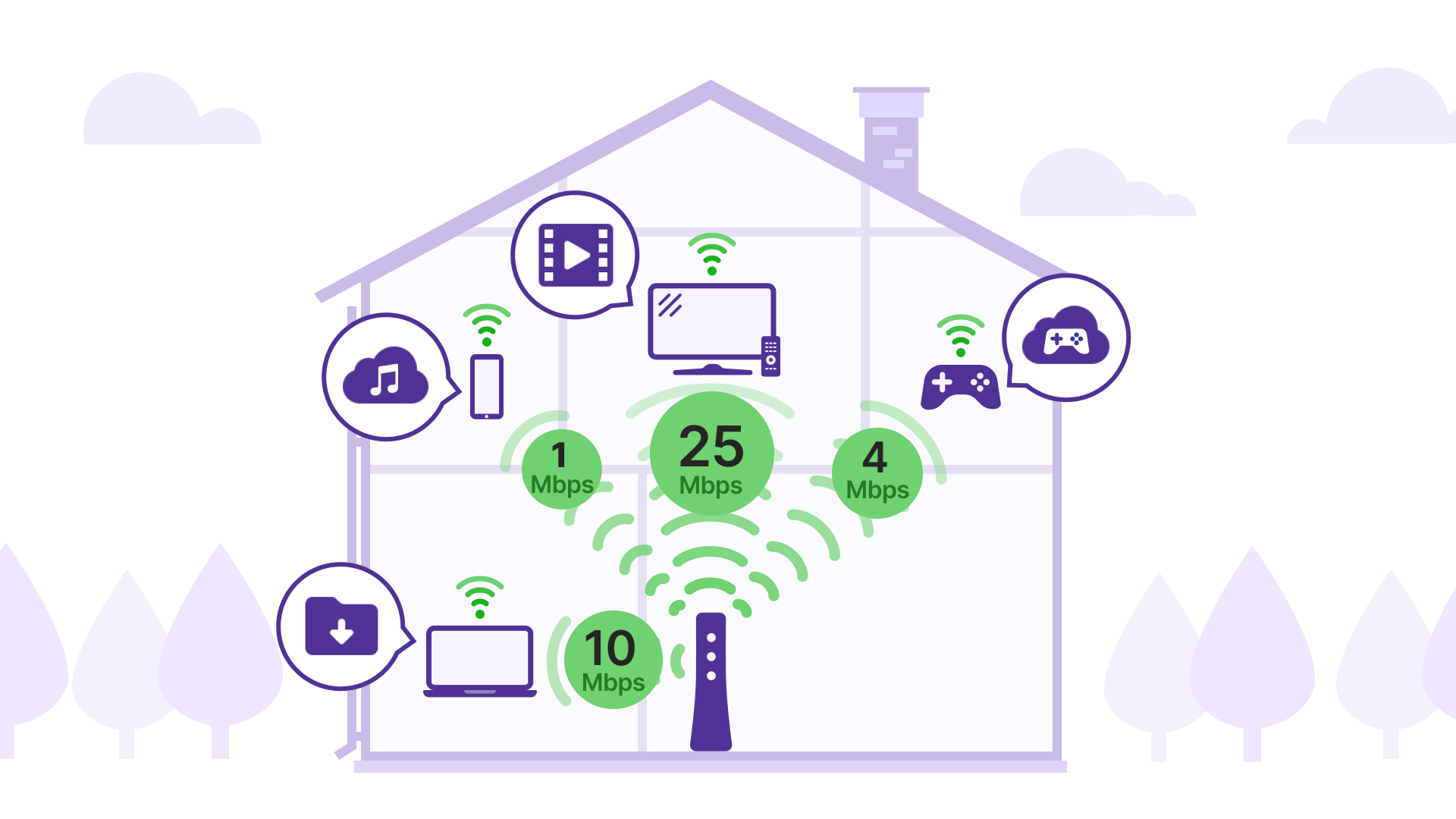¿Cuál es la mejor velocidad de Internet para ti?
Hoy en día, parece que cada familia usa Internet de una forma diferente. Por lo tanto, si estás considerando un nuevo servicio de Internet o una posible actualización, deberías preguntarte qué velocidad es mejor para ti.
Sin dudas, hay ciertas cuestiones que debes considerar, como el tamaño de tu familia y qué es lo que quieres hacer en línea. La buena noticia es que para la mayoría de las personas cualquier plan con velocidad de Internet de hasta 500 Mbps o 940 Mbps puede ofrecer un ancho de banda suficiente. En general, la opción se basa en cuántos dispositivos piensas tener conectados al mismo tiempo. Puedes usar nuestra evaluación de velocidad para descubrir cuáles son tus necesidades o seguir leyendo a continuación.
Requisitos de velocidad mínimos
Bien, hablemos sobre la velocidad. Conocer el ancho de banda recomendado para las actividades en línea más habituales es una excelente forma de determinar qué necesitas.
| Actividad en línea | Ancho de banda necesario para 1-2 usuarios | Ancho de banda necesario para 3-4 usuarios |
|---|---|---|
Transmisión de música |
1 Mbps |
2 Mbps |
Navegación web general, email, redes sociales |
1.5 Mbps |
3 Mbps |
Videochat personal en HD (alta definición) (FaceTime, Zoom, etc.) |
3 Mbps |
6 Mbps |
Transmisión de videos en SD (definición estándar) |
4 Mbps |
8 Mbps |
4 Mbps |
8 Mbps |
|
Transmisión de video HD |
5-8 Mbps |
10-16 Mbps |
Videoconferencia en HD |
6 Mbps |
12 Mbps |
Descarga de archivos grandes |
10 Mbps |
20 Mbps |
Transmisión de videos en ultra HD 4K |
25 Mbps |
45 Mbps |
Trabajo/educación a distancia |
25 Mbps |
45 Mbps |
Nota: Los números que se muestran representan el ancho de banda de descarga mínimo que se requiere. Los megabits por segundo (Mbps) son la medida estándar del ancho de banda y la velocidad del Internet.
Entonces, ¿cuál es la diferencia entre "ancho de banda" y "velocidad"? Es probable que escuches usar ambas palabras como sinónimos, pero tienen algunas pequeñas diferencias. Consulta varios artículos relacionados con la velocidad en nuestro blog (como Las velocidades de Internet explicadas) para más información.
Para descubrir el mejor ancho de banda total para tu hogar, suma el ancho de banda que necesitarás para todas tus actividades en línea que ocurran de forma simultánea en todos tus dispositivos. Luego, agrega un poco más para termostatos inteligentes, sistemas de alarma inteligentes o dispositivos conectados adicionales que puedas tener y que no hayas incluido.
Para poner esto en perspectiva, consulta estos ejemplos del mundo real.
Familia 1
Cantidad de personas |
2 |
Actividades en línea |
Trabajo remoto; transmisión de música |
Requisito mínimo de ancho de banda |
50 Mbps |
Familia 2
Cantidad de personas |
5 |
Actividades en línea |
Videos en transmisión; compras en línea; jugar en línea; aprendizaje remoto; trabajo remoto |
Requisito mínimo de ancho de banda |
500 Mbps |
Como puedes ver, incluso nuestro plan de velocidad más bajo de hasta 500 Mbps es suficiente para hacer todo eso. Imagina lo que se puede lograr con velocidades de hasta 940 Mbps o aquellos planes ultrarrápidos de “velocidad en gigas” de hasta 3 Gbps*. ¡No hay límites! Obtén más información sobre las velocidades en gigas.
* Disponibilidad, servicio y velocidad limitados solo en determinadas ubicaciones.

Diferentes necesidades de ancho de banda para los dispositivos conectados
Fuente: Datos de la Comisión Federal de Comunicaciones, 2022
Diferencia entre la velocidad de descarga y la de carga
Con Internet por fibra óptica, no solo obtienes velocidades de descarga ultrarrápidas, también puedes lograr velocidades de carga igual de rápidas. ¿Y cuál es la diferencia?
Velocidad de descarga (ancho de banda de descarga)
La velocidad de descarga es velocidad a la que tu conexión (y tu dispositivo) pueden enviarte datos de Internet. Una mayor velocidad de descarga te permite mirar videos en alta calidad con menos buffering y descargar grandes archivos rápidamente.
Los planes de Internet suelen poner en primer lugar el ancho de banda de la descarga y en segundo lugar el de la carga. Por ejemplo, una conexión de 100/10 Mbps te daría un ancho de banda de descarga de 100 Mbps y un ancho de banda de carga de 10 Mbps.
Velocidad de carga (ancho de banda de carga)
La velocidad de carga se refiere a cuán rápido tu dispositivo puede enviar datos a otro dispositivo en Internet. Al publicar una foto o video en los medios sociales, por ejemplo, usas tu ancho de banda de carga.
El servicio de Internet por fibra óptica hace que sea más sencillo lograr una conexión "simétrica", lo que significa que los anchos de banda de descarga y de carga tienen la misma velocidad.
¿Qué es el ancho de banda?
El ancho de banda de Internet es el volumen total de datos que pueden entregarse durante una determinada cantidad de tiempo. El ancho de banda, como la velocidad, se expresa en "Megabits por segundo" (Mbps).
Si bien el ancho de banda y la velocidad no son lo mismo, están muy relacionados y muchas personas usan ambos términos indistintamente. Cuanto mayor sea el ancho de banda del servicio, mayor será el volumen de información puede pasar a través de tu conexión, lo que también significa que verás velocidades más rápidas en tus dispositivos.
Ahora que sabes más sobre ancho de banda y velocidad, deberías poder decidir qué velocidad de Internet necesitas para tu hogar o tu empresa. Puedes explorar los planes de Internet por fibra óptica para ver si estás recibiendo el servicio adecuado para ti.
Este contenido se proporciona únicamente con fines informativos y es posible que el usuario final deba realizar una investigación y verificación adicional. Asimismo, la información es suministrada en el estado en el que se encuentra, sin garantía ni condición de ningún tipo, ya sea expresa ni implícita. El riesgo que implica el uso de esta información corre por cuenta del usuario final. Todos los nombres de empresas y productos o servicios de terceros mencionados en este artículo son solo para fines de identificación y no implican respaldo ni afiliación alguna con Quantum Fiber. Este documento representa los productos y las ofertas de Quantum Fiber a la fecha de su publicación. Los servicios no están disponibles en todos lados. Quantum Fiber podrá cambiar o cancelar productos o servicios, o reemplazarlos por productos o servicios similares, a su exclusivo criterio y sin previo aviso. ©2024 Q Fiber, LLC. Todos los Derechos Reservados. Quantum, Quantum Fiber y Quantum Fiber Internet son marcas comerciales de Quantum Wireless LLC y se utilizan bajo licencia de Q Fiber, LLC.
Temas relacionados
¿Fue útil esta información?








